NASA and its partners have given the green light for the Axiom Space’s fourth private mission to the International Space Station. This mission marks a significant milestone in the collaboration between NASA and private space enterprises. Led by former NASA astronaut Peggy Whitson, the crew is gearing up for a launch as early as spring 2025 from the Kennedy Space Center.
The upcoming launch of the Ax-4 mission aboard a SpaceX Dragon spacecraft is an exciting development in the field of private spaceflight. This mission will see astronauts from Hungary, India, and Poland traveling to join the International Space Station crew. The mission focuses on a mix of science, outreach, and commercial activities, further expanding the potential of low Earth orbit missions.
Meet the Pioneers of Ax-4
The Ax-4 crew brings together a unique set of talents from around the globe. Spearheading this mission, Peggy Whitson, a former NASA astronaut, will be taking on the role of commander. Shubhanshu Shukla from ISRO will serve as the pilot, showcasing his vast expertise. The mission specialists Tibor Kapu from Hungary and Sławosz Uznański-Wiśniewski from Poland complete this diverse team.
Each member of the crew adds a distinct perspective to the mission. Whitson’s experience and leadership ensure a steady hand at the helm. Shukla’s role as the first ISRO astronaut to the station is a source of pride for his country. Kapu and Uznański-Wiśniewski represent the first astronauts from their respective nations, highlighting the growing international cooperation in space exploration.
Mission Objectives and Goals
The Ax-4 mission is not just about traveling to space. It encompasses a multifaceted program involving scientific research, educational outreach, and commercial activities. The team will be conducting experiments that are only possible in the unique conditions of space. This includes studies ranging from biology and physics to new technologies that could have applications here on Earth.
These ambitious goals aim to push the boundaries of what we know. The crew is expected to stay on the International Space Station for up to 14 days, providing ample time to engage in valuable research. Their work not only contributes to our understanding of space but also paves the way for future missions that might push even further into the cosmos.
A Legacy of Private Missions
NASA’s partnership with private companies like Axiom Space is part of a broader strategy to promote low Earth orbit economies. This collaboration is crucial as NASA transitions towards more commercial operations in space. Axiom Mission 1 marked the beginning of this new era when it launched in April 2022.
The success of these missions is measured not just by the experiments conducted but by the doors they open for future endeavors. The Ax-4 mission builds on the lessons learned from the previous Axiom missions, leveraging them to enhance both safety and productivity in space. This mission, like others before it, is a stepping stone towards sustainable private space exploration.
Expanding Horizons for Nations
For the first time, astronauts from India, Hungary, and Poland will be part of a mission to the ISS. This is a momentous achievement for these countries, broadening their participation in global space exploration. The inclusion of diverse international teams enriches the mission with varied insights and expertise.
Working with NASA, these nations contribute to a global effort to explore and utilize space effectively. By participating in these missions, they are not only advancing their own space programs but are also playing a role in the collective human endeavor to reach further into space. It’s an opportunity for these nations to develop their capabilities and inspire future generations.
The Future of Space Collaboration
NASA’s focus on fostering collaboration with private companies is steering the future of space exploration towards a more accessible and sustainable model. By encouraging commercial partnerships, NASA aims to expand its research capabilities while supporting the burgeoning space economy.
The Ax-4 mission exemplifies these efforts, as it showcases how government agencies and private enterprises can work together to achieve ambitious goals in space. This collaboration is pivotal as humanity continues to explore the final frontier.
The path set by the Ax-4 mission is expected to lead to increased private sector involvement in space, fostering a more dynamic and inclusive approach to exploring the cosmos.
The Ax-4 mission marks a new chapter in space exploration, bridging international collaboration with private enterprise. This launch indicates a promising future in which diverse nations work together in space. As we look ahead, the mission exemplifies how partnerships can foster innovation and inspire global cooperation to reach new heights.












